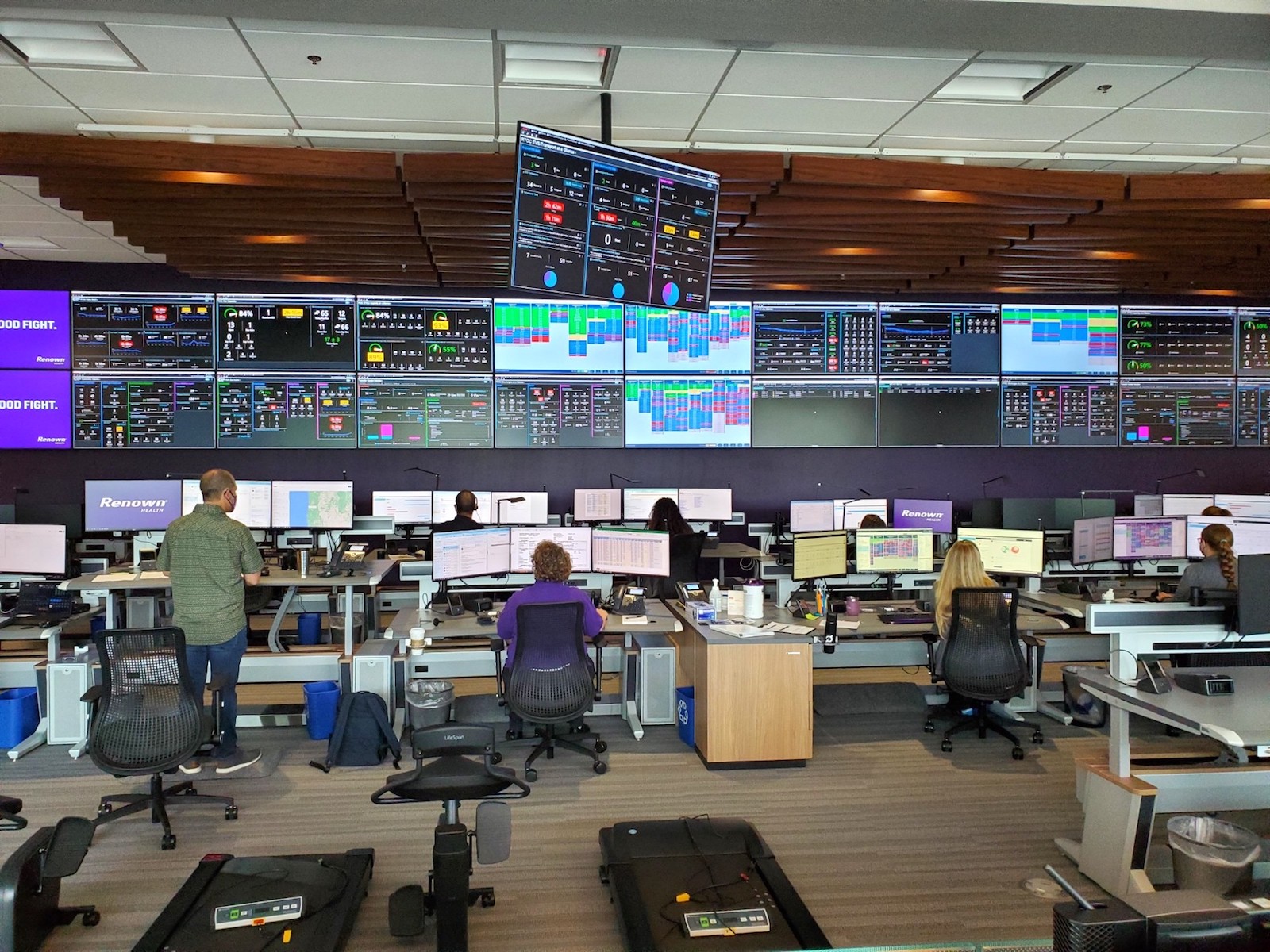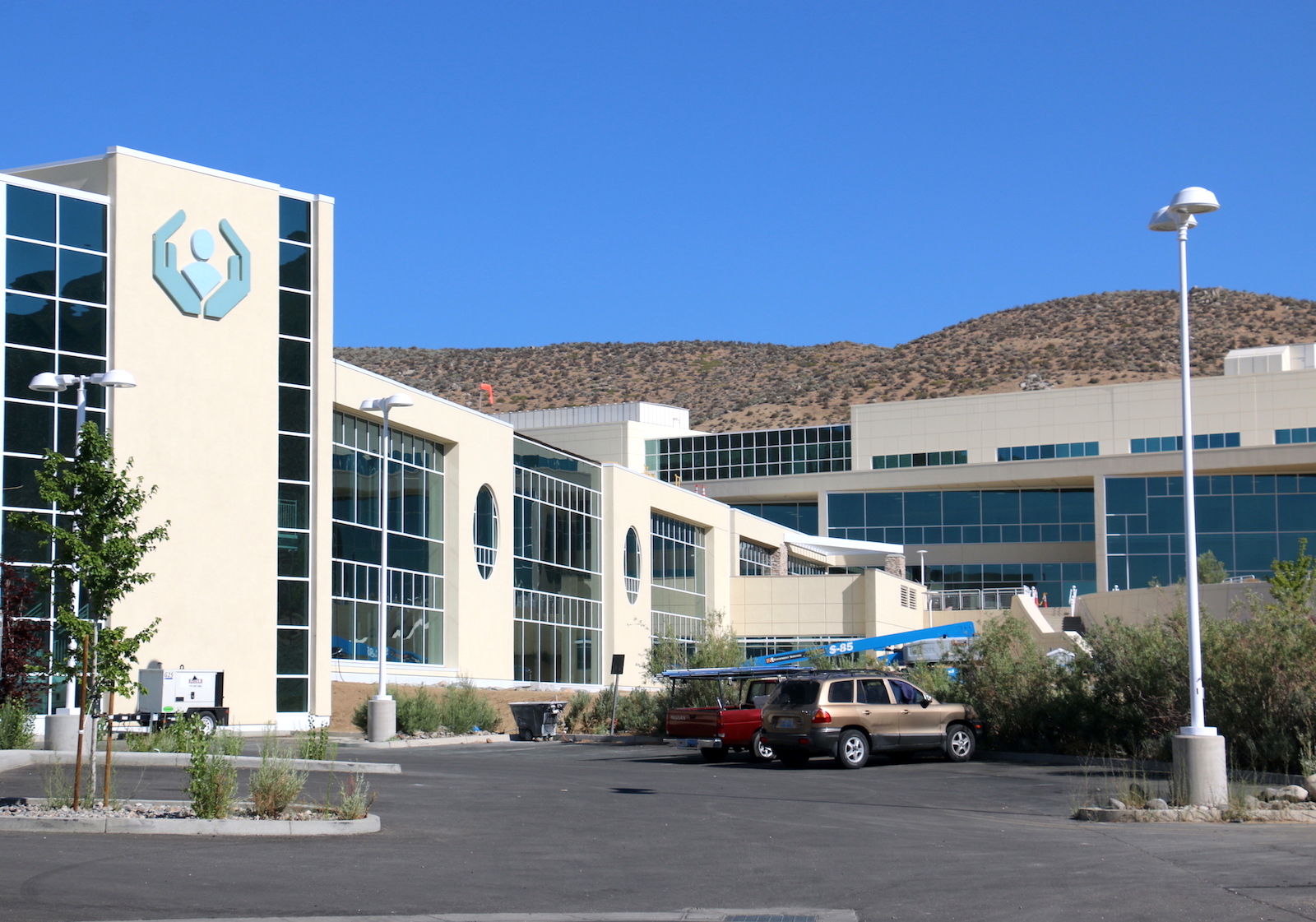An aerial view from the summer of 2021 of construction progress at the new Northern Nevada Sierra Medical Center being built at Double R Boulevard and Longley Lane in South Reno.
Photo: Northern Nevada Health System
EDITOR’S NOTE This story is adapted from the 2021-2022 edition of the Northern Nevada Guide, a 116-page specialty magazine published in late September by the Northern Nevada Business Weekly. Go
here to read the digital edition.
By early spring, Northern Nevada will see its first new hospital in 100 years come to life.
Northern Nevada Sierra Medical Center, which is being built on a patch of land at Double R Boulevard and Longley Lane in South Reno, is on track to open its 350,000-square-foot medical campus in late March 2022, Alan Olive, CEO of Sierra Medical Center, said in an August 2021 interview.
“We’re making magnificent progress on every level,” Olive said.
Built with 4,000 tons of steel, SMC will house nearly 200 private patient rooms and an array of comprehensive services: emergency care, orthopedics, surgery, labor and delivery, neonatal intensive care, oncology, cardiovascular and neurological. Outpatient services will also be provided.
Breaking ground in February 2020, the project is an investment of nearly $300 million by Northern Nevada Health System. Northern Nevada Medical Center, the healthcare network’s acute care hospital in Sparks, has 122 beds — meaning, SMC will nearly triple the number of beds the healthcare network will provide the entire Northern Nevada region.
If the pandemic taught the region’s healthcare industry anything, it’s that an increase in hospital beds and access to care is needed, Olive said.
After all, Reno-Sparks’ population is projected to increase by more than 100,000 residents over the next 10 years, according to the Northern Nevada Economic Planning Indicators Committee.
“We’re a fast-growing region,” Olive said. “We saw what happened during COVID; the hospitals were unable to accommodate all of the patients.”
What’s more, Olive said the pandemic showed the region’s need for a “full, complete health system of care” that invests in the community’s health to get them access to care at a good cost, at the best quality.
Olive went on to elaborate some of the highlights of the Sierra Medical Center.
“What this hospital does is, one, provides 100% private rooms for every individual that enters its doors,” he said. “Two, it provides the latest in infection control technology. And three, it provides lighting technology called indigo lighting, which helps kill viruses and bacteria, and that’s going to be put in all of our surgery suites and procedure rooms. In addition, we’ll have infrared robots that will be programmed to go into vacant patient rooms for the final disinfecting of the rooms.
“It means a lot for the community because we’re elevating services and elevating patient satisfaction and safety.”
The new Sierra Medical Center being erected in South Reno — which should provide increase options for patients in Carson City as well as Reno-Sparks — is just one example of healthcare providers in greater Northern Nevada expanding footprints and services in response to the region’s booming population. Renown Health in August 2021 opened its new Renown Transfer and Operations Center, which serves as a logistical “traffic control center” for patients and providers across 27 counties. Photo: Renown Health
Renown Health in August 2021 opened its new Renown Transfer and Operations Center, which serves as a logistical “traffic control center” for patients and providers across 27 counties. Photo: Renown Health
In August, the region’s largest medical provider, Renown Health, officially opened its Renown Transfer and Operations Center (RTOC) in South Reno. The new facility serves as a logistical “traffic control center” for patients and providers for 27 counties across Northern Nevada, Lake Tahoe and Northeastern California.
Staffed 24/7 by Renown doctors, nurses and technicians, the RTOC is used to track patients and provide them with the best care for their needs as quickly as possible.
“This is ‘mission control’ for the healthcare system,” RTOC Director Melanie Morris said. “In the absence of something like this, you’re doing a lot of siloed work. You really need this eye-in-the-sky view to maximize those efficiencies and best utilize those valuable in-patient beds.”
The 6,000-square-foot facility is equipped with 28 high-definition dashboards on the front wall, two in the center room and four hanging monitors toward the back. Registered nurses and dispatchers monitor activity around the clock across Renown’s 100,000-square-mile service area to make the best decisions for patients, providers and care teams.
“The goal is really to help improve the efficiency and access to care for patients,” said Paul Sierzenski, chief medical officer of acute services at Renown Health. “We’re connecting the referring facilities with a specialist who can help give guidance to them when they’re transferring a patient. And so, if they have an ICU patient, they likely could be speaking with a critical care doctor; or a neurosurgical patient could speak with a neurosurgeon; or if they’re unsure, and they just need to send the person to the ED (emergency department), we’re able to guide that information.
“It’s really about driving performance and access for the community.”
Meanwhile, Renown in November 2020 announced a $469 million investment in improvements to its two campuses — upgrades include infrastructure, capacity and technology improvements to both towers at the main 808-bed Renown Regional Medical Center campus east of downtown Reno, as well as the 138-bed Renown South Meadows Medical Center in South Reno.
A year ago, Renown said work was slated to begin in spring 2021, and a “majority” of the full project would be completed by fall 2023. As of August 2021, though, Sierzenski said they are still in the planning stages and in the process of acquiring loans to fund the work.
“Because it’s such a broad set of plans and covers both campuses, that planning includes meeting with the consultants who helped with the design as well as the contractors,” Sierzenski said. “And meeting with the care teams on what is necessary and appropriate for that master facilities project.” Carson Tahoe Health’s new Carson Tahoe Walkway connector, which was completed in summer 2021, bridges Eagle Valley Creek. Photo: Faith Evans
Carson Tahoe Health’s new Carson Tahoe Walkway connector, which was completed in summer 2021, bridges Eagle Valley Creek. Photo: Faith Evans
Meanwhile, in Carson City, another major healthcare network is in the middle of the first phase of a $40 million master plan expansion.
Carson Tahoe Health broke ground on several projects in October 2019, kicking off the first phase of its 10-year master plan. That included the expansion of health system’s emergency department, as well as completion of a two-level enclosed walkway connector between the Regional Medical Center and Sierra Surgery.
With the connector, it marks the first time since Carson Tahoe Health acquired Sierra Surgery in 2015 that staff and patients no longer have to walk or drive several minutes to get from one building to the other. The 500-foot Carson Tahoe Walkway, which bridges across Eagle Valley Creek, fully opened in late summer 2021.
“It’s really going to change how people access care and how our staff are able to provide it between the two buildings,” Michelle Joy, chief operating officer at Carson Tahoe Health, said. “One of the biggest things for us — and it really became identified last year during COVID — is that it became really evident that the ability to move patients in-between the two buildings was critical.”
Over the summer, Carson Tahoe Health also wrapped up a 20,000-square-foot expansion of the Regional Medical Center lower level. About half of the addition will be dedicated to a new lab, Joy said, and the rest will be used for the extension of existing support services, including housekeeping, materials management and biomedical engineering.
And last February, Carson Tahoe Health finished a 6,600-square-foot addition to its emergency room. The ER expansion added nine treatment rooms, bringing the hospital’s emergency department capacity to 32 rooms.
Meanwhile, the Regional Medical Center is also in the middle of a multi-year project “to update and energize” every patient room.
“When you look at long-term economic development and growth for the area, it is extremely critical that we have quality healthcare services and access for everybody,” Joy said. “And so that’s a challenge for all of us in this area. How do we ensure that, as the population grows, we’re continuing to be able to recruit physicians into the area, provide housing, schools, everything that goes to growing a community and making a community one of the places that people want to come and live and raise their families and open their businesses.”
Looking forward, Joy said Carson Tahoe Health has also identified opportunities to expand services and technology in its medical centers in both Minden and Dayton.
“As we look at future planning, it may not be around brick-and-mortar,” Joy said. “It’s probably more around types of services we’re providing, new technology that we’re able to bring in … all investments that were identified as part of the long-term planning for the organization.”
Additionally, an expansion project began last year at Carson Tahoe Behavioral Health Services’ Mallory Crisis Center, thanks to an $800,000 donation from the Mallory Foundation.
The project brings the total number of patient beds in the crisis center to 15, as well as adding triage/holding spaces for shorter stay patients, and three extra offices for additional providers.
 Renown Health in August 2021 opened its new Renown Transfer and Operations Center, which serves as a logistical “traffic control center” for patients and providers across 27 counties. Photo: Renown Health
Renown Health in August 2021 opened its new Renown Transfer and Operations Center, which serves as a logistical “traffic control center” for patients and providers across 27 counties. Photo: Renown Health Carson Tahoe Health’s new Carson Tahoe Walkway connector, which was completed in summer 2021, bridges Eagle Valley Creek. Photo: Faith Evans
Carson Tahoe Health’s new Carson Tahoe Walkway connector, which was completed in summer 2021, bridges Eagle Valley Creek. Photo: Faith Evans
Comments
Use the comment form below to begin a discussion about this content.
Sign in to comment